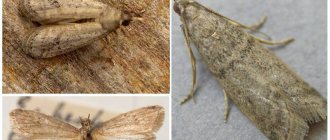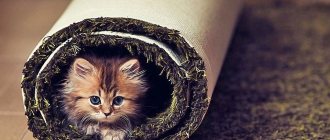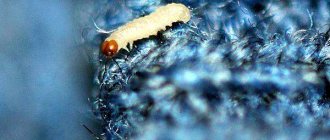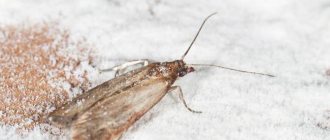What does an apple moth look like (photo)
Apple moth.
Description of apple tree leaf miner
Name: Apple moth Lat.:
Hyponomeuta malinellaClass: Insects - Insecta Order: Lepidoptera - Lepidoptera Family: Ermine moths - Yponomeutidae
| Habitats: | garden |
| Dangerous for: | fruit trees |
| Means of destruction: | biological complexes, pheromone traps. |
Traces of moth activity.
The apple moth is a member of the ermine moth family. The insect's body is covered with a chitinous shell that protects from cold and is 12-15 mm long.
The moth has 2 pairs of wings, the front ones are whitish with black spots, the rear ones are gray with a frame.
The apple moth lives in Europe - in Sweden, Finland, Britain, in North America - in the USA and Canada, in Russia - in Siberia. Most often it parasitizes the apple tree, but it can infect various fruit trees - plum, cherry, pear.
Stages of development
Butterflies appear in early summer, in June. At first they hide in the grass, after they get stronger, they sit on the inside of the leaf, and in the evening they begin to fly actively. After mating, females lay eggs mainly on the bark of apple trees.
Apple moth butterfly.
Moth caterpillar.
The eggs are covered with mucus, which forms a kind of shield; each pile consists of 15-50 eggs. A month later, larvae emerge from them.
The color of the caterpillars is light beige, the head and legs are black, and there are dark spots with black dots on the back. They remain overwintering under the shield, feeding on the bark and shell of the egg. In the spring they settle on the young leaves of the apple tree, gnawing at the base of the leaf and penetrating inside; the leaves then darken, dry out and fall off.
Coming to the outer surface of the leaves, the caterpillars cover them with a secretion similar to a cobweb. In early May, caterpillars settle on the tops of branches, building nests on them from cobwebs; their number can reach one thousand. In the second half of May, the pests pupate; white cocoons are located in groups in the axils of the branches.
The process of turning a pupa into an adult insect - imago - takes 12-14 days, butterflies appear 30-45 days after the apple tree blooms. After leaving the cocoon, the females begin to actively mate and lay eggs a week later. The summer period lasts until the end of summer.
Description of fruit moth
The larva looks like a small worm. The body length of the larva is 15 millimeters. The body is soft, has a fine structure, and is covered with a large number of black dots. The color of the larvae can vary with age and change after molting from gray to yellow. The head and pectorals are black.
Fruit moth (Hyponomeuta pattella).
The pupa is smaller in size than the larva - its length is 7-11 millimeters. The pupa has clearly visible rudiments of a black head and wings, and also has 6 small legs. The color of the pupa is dark yellow.
An adult fruit moth has a wingspan of about 2 centimeters. There are a large number of hairs on the head, they are smoothed in the front part, and form a tuft at the back of the head. The front wings are elongated and oval in shape. The color of the front wings is white with scattered black spots, the number of which reaches 15-20 pieces. The hind wings have a smoky color, they are framed by a thick border, also smoky in color.
Fruit moth pupa.
The differences between females and males are only in the structure of the genital organs.
Why is apple moth dangerous?
Apple moth larvae are capable of eating large amounts of young greenery on fruit trees, which disrupts photosynthesis in the leaves. This leads to a lack of nutrients required for the formation of ovaries.
When severely damaged, the tree does not bloom or bear fruit. These pests are also dangerous because by weakening the plant, they deprive it of frost resistance, and in extreme cold it can die.
What harms a butterfly or caterpillar?
An adult insect indirectly harms trees - females lay eggs after mating, from which larvae subsequently emerge. The damage is caused by caterpillars; they feed on the juices and leaves of apple trees, causing the death of young shoots and ovaries.
Apple moth caterpillars.
Harmfulness of fruit moths
Fruit moth caterpillar: even at an intermediate stage of development, the insect causes great harm.
These pests prefer to feed on the leaves of stone fruit trees: plum, cherry, apricot, quince, apple, peach, pear and sloe. In addition, fruit moths can develop on willows and oaks.
The pests are caterpillars; they eat the leaf blades. As a result of this impact, trees weaken and lose resistance to frost. Damaged trees are susceptible to infection by a variety of infections, and they cannot resist attacks from other pests.
If you find an error, please select a piece of text and press Ctrl+Enter.
Methods to combat apple moth
To protect fruit trees and preserve the harvest, it is necessary to prevent the emergence and spread of this dangerous pest and measures should be started in early spring. Both folk remedies and chemical preparations are used. During the period of bud formation, spray the first time, the second time after flowering. Repeat the treatment at the end of August - beginning of September.
Treatment with biological complexes
Treatment with biological complexes is a more harmless method, but, compared to chemical insecticides, not as effective. These products are used to treat trees with a low degree of fruit moth infestation and use them for preventive purposes.
These include:
- entobacterin;
Moth damage to young leaves.
- "spark-bio";
- bitoxybacillin.
The preparations involve preparing a solution from a dry mixture. Spraying with them is carried out in the spring, when the air warms up to +10...15°C. Before the flowering period begins, it can be processed several times. To prevent the appearance of apple moths, spray with biological solutions in mid and late summer.
Treatment with chemical compounds
In case of severe damage to fruit trees by larvae, chemical agents are used; they have a more effective and lasting effect, but are toxic.
These are: Inta Vir, Fozolon, Kinmiks. They must be used as indicated in the instructions, observing the dosage and using protective equipment.
When to treat apple trees with preparations against longhorned beetle and sawfly pests?
The small maple longhorned beetle (Rhopalopus macropus) is a black beetle, narrow-bodied, with long antennae. The larva is yellowish-white, legless. It gnaws passages in trunks and branches, which disrupts sap flow and plant development. The longhorned beetle damages all fruit crops, especially apple trees. The mass flight of beetles occurs in late May - early July.
In addition to the small maple barbel, there is the musky barbel.
Control measures. Compliance with all agricultural technology requirements. To treat apple trees after flowering against these pests during the mass flight of beetles, one of the following drugs is used: fufanon, kemifos, actellik, decis, spark, Inta-Vir
The apple sawfly (Hoplocampa testudinea) is a brown insect with transparent wings. The larva is white, with a brown head and an unpleasant odor. The larvae overwinter in the soil at a depth of 20 cm. Adult insects emerge from the pupae before flowering, and fly in large numbers during the flowering period of the apple tree. Apple trees of early varieties are more severely damaged. Females lay eggs one at a time in sepals or receptacles. The fertility of one female is 50-90 eggs. After 7-14 days, the larvae hatch. One larva damages up to 6 fruits. Fruits in which the seed chambers are not damaged continue to develop, but the scarred suberized tissue remains on the fruit in the form of a belt. In June, the larvae finish feeding and go into the soil, where they overwinter. The damage caused by the sawfly is similar to that of the codling moth. The difference is that the exit holes in fruits damaged by the codling moth are dry and covered with dry excrement and cobwebs. The holes after the sawfly larva emerge remain open and a rusty red liquid flows out of them. By mid-summer, almost all damaged fruits fall off. Damage can lead to complete destruction of the crop.
Control measures. To treat apple trees against these pests in the spring, just before flowering they are sprayed with one of the following preparations: fufanon, kemifos, actellik, spark, Inta-Vir. Immediately after flowering, spraying is repeated. Collection and deep burial to a depth of 50-70 cm of ovaries damaged by larvae.
The next section of the article is devoted to how to deal with pests of apple trees, the codling moth and the case-bearing moth.
Folk remedies against moths
Folk remedies for treating apple moths are considered safe for plants and humans. But they are used in cases of minor pest infestation of apple trees and for prevention. But you need to take into account that over time, fruit moths develop immunity to such agents, and they stop working.
Hot pepper
To destroy the larvae, use an infusion of hot pepper. It is prepared like this: add 10 pepper pods to 1 liter of water and boil for an hour in a tightly closed pan. Then cool and leave for 24 hours. Before spraying, add a solution prepared from laundry soap (30-50g) so that the tincture remains on the crown and bark of the tree longer.
Pepper tincture.
Tobacco
Tobacco tincture is used to repel apple moths from fruit trees. To prepare it, take 500-700 grams of tobacco, pour 8-10 liters of boiling water and let it brew for three days. Then filter, add a soap solution, and the tincture is ready. The branches are treated with tobacco infusion until greenery appears.
Tobacco tincture repels moths.
Moths are a pest in the kitchen
It is not the fruit moth that appears in the apartment, but its other varieties. Whatever they call it: fruit, food, grain, cereal, potato, household. Mostly they all belong to the moth butterfly family. Adults are distinguished by their inconspicuous gray or brown color and medium-sized dimensions. Adults do not feed on anything, unlike the voracious larvae, which are small pink and cream-colored caterpillars.
In most cases, food moths enter an apartment with contaminated cereals, dried fruits, and occasionally through open windows and ventilation holes. Once in the food substrate, insects feed, develop, and reproduce. Flying butterflies do no harm. Their function is reduced to laying offspring. The damage is caused by larvae that destroy food supplies, leaving excrement in them and making tunnels. Contaminated foods should not be eaten.
On a note! If you see a flying food moth in your apartment, be prepared for the fact that a large family of caterpillars is safely nestled in one of the bags of bulk food.
Getting rid of fruit moths in an apartment is quite simple:
- A thorough audit of all stocks of cereals, dried fruits, nuts, pasta should be carried out, and all stale stocks should be checked. If larvae are found, the food must be disposed of. If the individuals have not had time to reproduce, some housewives save the provisions by placing them in the freezer for a day or in the oven for 30-40 minutes.
- Wash all kitchen cabinets, their shelves and internal surfaces with a disinfectant or vinegar solution.
- Adult butterflies are destroyed mechanically or using glue traps.
Using insecticides to bait moths in the kitchen is not always safe. Therefore, to repel pests, place cloves of garlic, citrus peels, bay leaves, walnuts, dry wormwood, cotton swabs soaked in camphor oil or oils of rosemary, wild rosemary, and basil.
To prevent the appearance of food moths in the apartment, purchased bulk products should be visually inspected, if possible, kept in the oven for several minutes and stored in sealed containers. Moths do not like drafts, so regularly ventilating food cabinets will reduce the likelihood of the pest appearing.
Mechanical methods
Pheromone trap.
Mechanical methods can reduce the degree of infestation of fruit crops by apple moth. If visually detected, cocoons and nests are collected and destroyed (burned).
At the end of the autumn period, the area is cleared of fallen leaves. Also, for preventive purposes, they dig up the soil near the trees. Before the beginning of the growing season, sanitary pruning of branches is carried out, and the trunk and main branches are whitewashed.
Pheromone traps are used to kill males This is a device with a sticky bottom, inside of which a capsule with synthetic pheromones is placed. Male butterflies fly to the smell, stick to the adhesive base and remain trapped. Females are deprived of mating and cannot produce offspring. The effect of the capsule is designed for 1.5-2 months; one trap is enough for one tree.
To catch butterflies, they also use adhesive tapes hung on branches, and for caterpillars - glued to the trunk.
How to deal with a pest
The combined use of chemical, biological and mechanical means allows the destruction of moths and their offspring.
Mechanical destruction
Spider nests and cocoons are clearly visible on the tree. They must be cut and burned. Brown leaves in which young caterpillars live are also collected. This measure is effective in small areas in private gardens.
Pheromone traps
To attract males, female moths secrete special substances - pheromones. To create traps, these substances are synthesized artificially. The capsule with pheromones is placed in a structure with an adhesive bottom. Male butterflies are attracted by the strong aroma, they fly inside and stick. There are always fewer males than females. When the males are destroyed, the females remain unfertilized and cannot give birth to offspring. The effect of one capsule is enough for 1-1.5 months.
The number of traps is one per tree. It is hung under protection from direct sunlight. It is better to hang traps in advance, a week before the start of butterfly summer. This will increase the chances of preventing their active reproduction.
Trap belts and sticky traps
Paper sheets coated with a sticky compound are hung between the branches. You can make them yourself or buy ready-made ones. To attract insects they are made yellow. Butterflies stick to traps during summer. Hunting belts are adhesive strips attached to the trunk. They are designed for crawling insects.
Biological control method
The ermine moth has virtually no natural enemies. Butterflies have adapted to camouflage themselves on leaves, but birds do not eat caterpillars. The only way to reduce the pest population is to use the ageniaspis ichneumon. It is a parasite that lays eggs in moth eggs. Ageniaspis development takes almost a year. All this time the larvae, the parasite is in the body of the caterpillar. The rider leaves the host's body during the caterpillars' pupation period. The shell left from the apple moth can contain up to 100 parasites.
Gardeners are advised to collect mummified caterpillars from which ageniaspis are ready to fly. These insects feed on nectar and are therefore safe for trees. When the time comes to reproduce, they will infect the eggs of a new generation of garden pests. The life cycle of the parasitic wasp is focused on the characteristics of the apple moth.
Chemical treatment
Without the use of insecticidal preparations, it is impossible to completely solve the problem of pest control. This is especially true for growing apples on an industrial scale. Spraying is carried out in early spring before flowering. The drugs used are Actellik, Inta-Vir, and Fozalon. A safer treatment option is biological insecticides:
- “Entobacterin” is made from bacterial spores, and when it enters the caterpillar’s body, it causes death.
- "Lepidocid" is an intestinal drug created from microbes. Affects pests within 4 hours.
- "Bitoxibacillin" is a bacterial remedy against gnawing insects.
Apple moth is a pest that will certainly take advantage of people’s carelessness. In the absence of annual treatments of apple trees with pesticides and preventive measures, a catastrophic increase in the pest population may occur.
Natural enemies of the apple moth
Tahin fly.
The natural enemies of apple moths are parasitic insects such as braconid wasps and tahini flies. They lay eggs inside apple moth eggs or in the body of an adult insect. For feeding, the parasitic larvae begin to use the tissues and organs of the host, and the host dies.
Birds help destroy the butterfly population, so birdhouses are installed in garden plots to attract them.











